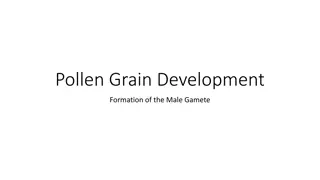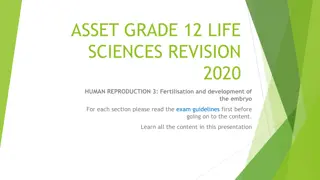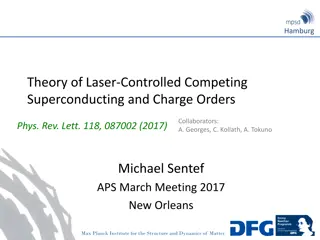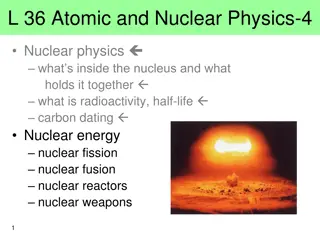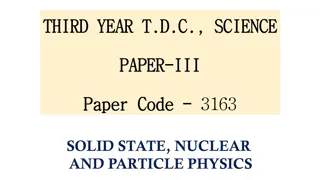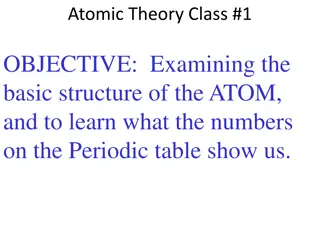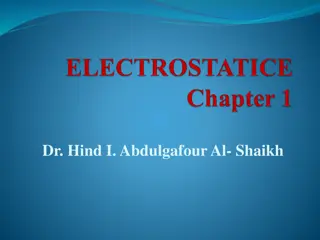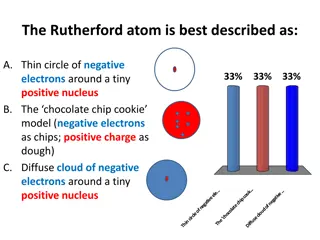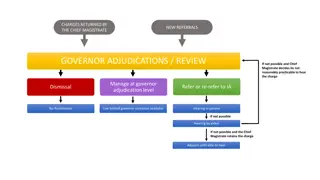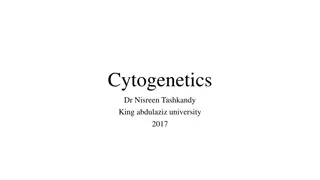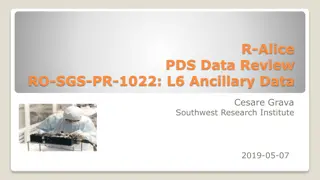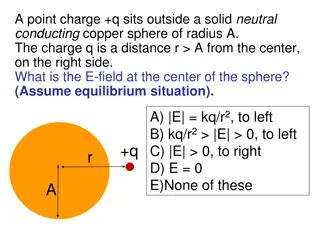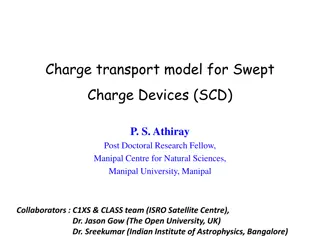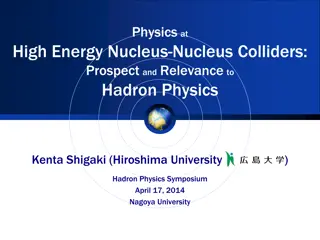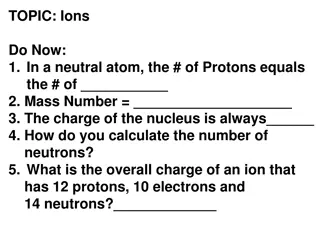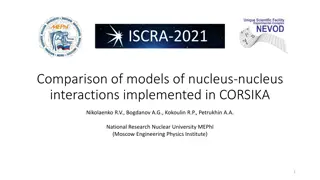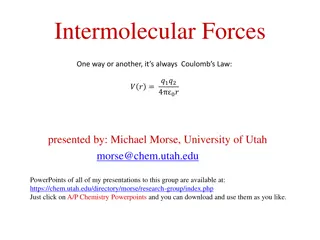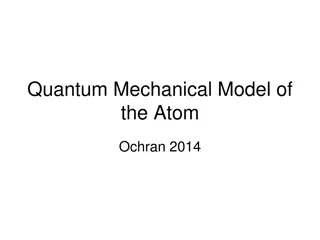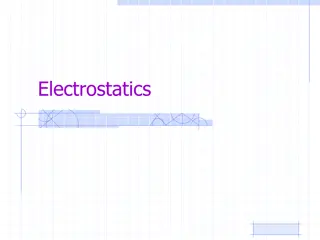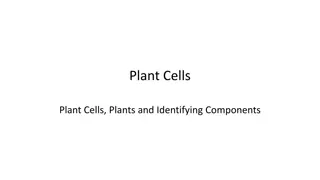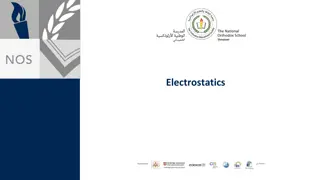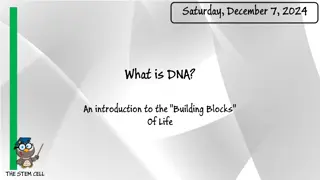Comparative Analysis of Positive Charge's Charging Stations Evolution
This PowerPoint template example created by Romy Bailey for Positive Charge showcases a comparative study of high-speed charging stations versus traditional charging stations, along with a comparison of past year versus current year data, and a year-over-year analysis of Positive Charge's growth. It
1 views • 6 slides
Understanding Models of the Atom: Nucleus, Protons, Electrons
Dive into the fundamental concepts of atoms, exploring their structure with a focus on the nucleus, protons, electrons, and neutrons. Discover how the periodic table reveals crucial information about elements, such as atomic number and mass number. Explore the evolution of atom models and the necess
3 views • 20 slides
Pollen Grain Development
The process of pollen grain development and formation of the male gamete involves crucial stages such as the presence of diploid microspore mother cells in the stamen, meiosis resulting in the formation of four haploid cells and tetrads, mitosis leading to the development of two haploid nuclei in ea
0 views • 6 slides
Human Reproduction: Fertilisation and Embryo Development Overview
Human reproduction involves the complex processes of fertilisation and embryo development. Fertilisation occurs when the nucleus of a sperm cell fuses with the nucleus of an ovum to form a zygote. The zygote undergoes mitosis to develop into a blastocyst, which then implants into the endometrium. Th
0 views • 12 slides
Understanding White Blood Cells and Their Classification
White blood cells (WBCs), or leukocytes, are vital elements of the blood responsible for protecting the body against invading organisms. They are classified into granulocytes (neutrophils, eosinophils, basophils) and agranulocytes (monocytes, lymphocytes), each playing specific roles in the immune s
1 views • 28 slides
Positive Charge Brand Audit Presentation
Conducting a brand audit is crucial to evaluate the effectiveness of Positive Charge, an EV-charging provider striving to reduce the environmental impact of fossil-fuel cars. The audit covers aspects such as brand identity, customer perception, values, competition analysis, and goals alignment to de
0 views • 7 slides
Understanding Current, Resistance, and Charge Motion
Explore the fundamentals of current flow, resistance, and charge motion in this chapter. Learn about the factors influencing current, the behavior of free electrons in metals, and the impact of potential difference on charge motion. Discover Kirchhoff's laws and how current density is calculated.
0 views • 40 slides
Laser-Controlled Competing Superconducting and Charge Orders in Transition Metal Dichalcogenides
Hamburg Theory of laser-controlled competing superconducting and charge orders explores the use of lasers to manipulate the ordering mechanisms in transition metal dichalcogenides, leading to ultrafast switching and the induction of new states of matter. This research delves into generic mechanisms
0 views • 13 slides
Understanding Nuclear Physics: Inside the Nucleus and its Impact
This content explores nuclear physics, covering topics like what's inside the nucleus, radioactivity, half-life, carbon dating, nuclear energy, fission, fusion, reactors, and weapons. It delves into the structure of the nucleus, radioactive decay processes, nuclear reactions, biological effects of r
0 views • 29 slides
Understanding Solid State Physics - Crystal Structures, Binding, and Nucleus Properties
Delve into crystallography, solid-state binding, semiconductor conduction, nucleus structure, and particle detectors in this comprehensive syllabus for Third Year T.D.C. Science students.
0 views • 16 slides
Understanding Diffraction Processes and Meson Production in Nuclear Interactions
Exploration of diffraction dissociation of nuclear nucleons in nucleus-nucleus interactions using Geant4 FTF model and NA61/SHINE results for various nucleus combinations. Insights into meson production in argon-nucleus interactions at different energies and the impact of models like DCM/AGT, UrQMD,
0 views • 17 slides
Understanding the Basic Structure of Atoms: Atomic Theory Class #1
Exploring the fundamental components of atoms, including protons, neutrons, and electrons, their charges, symbols, masses, and locations within the atom. We delve into the concept of atomic mass units (AMU) and the structure of the nucleus, as well as the behavior of electrons in relation to the nuc
0 views • 108 slides
Understanding Electric Charges and Conductors in Physics
Explore the fundamentals of electrostatics, electric charges, conductors, and insulators in physics. Learn about the Law of Electric Charges, types of charge, conductors vs. insulators, and methods of charging objects through friction, conduction, and induction. Dive into the world of atoms, electro
1 views • 14 slides
The Rutherford Atom and Its Structure
The Rutherford atom is characterized by a thin circle of negative electrons surrounding a tiny positive nucleus. In this model, the electrons are in a diffuse cloud around the nucleus, forming the majority of the atomic volume but only a small fraction of the mass. Protons define an element's atomic
0 views • 17 slides
Exploring Atom Structure and Properties Questions
This series of questions delves into the intriguing world of atoms, covering topics such as atom size comparison, proton count identification, location of metals on the Periodic Table, nucleus charge explanation, atomic number significance, various arrangements of the Periodic Table, subatomic parti
0 views • 12 slides
Procedures and Criteria for Adjudication of Charges by Chief Magistrate
The process of adjudicating charges returned by the Chief Magistrate involves detailed steps, including review by the governor adjudication level and independent adjudicator referral. Factors such as procedural fairness, evidence quality, and seriousness of the charge are considered. If a charge is
0 views • 5 slides
Understanding Chromosome Territories in the Nucleus
Chromosome territories refer to specific regions in the nucleus where chromosomes are organized. While chromosomes appear as condensed structures during cell division, they have a different appearance in non-dividing cells like neurons. Scientists have used microscopy to study chromosome organizatio
0 views • 17 slides
Introduction to Histology and Cell Structure
Histology is the microscopic study of normal tissues utilizing light and electron microscopes. This field explores the composition and function of cells, focusing on the nucleus, cytoplasm, organelles, and inclusions. Thin tissue sections stained with Haematoxylin and Eosin reveal distinct cellular
0 views • 23 slides
Understanding Histology and Cell Structure Fundamentals
Delve into the intriguing world of histology and cell structure, exploring the composition of cells, the functions of various components like the nucleus and cytoplasm, and the significance of organelles. Discover how histology is studied, the types of microscopes used, and the vital role of the cel
0 views • 24 slides
Detailed Review of R-Alice PDS Data - Southwest Research Institute
Content discusses the R-Alice PDS data review conducted by Cesare Grava from Southwest Research Institute. It includes details on FUV imaging spectrograph specs, objectives of R-Alice, study goals related to comet nucleus, atomic budget analysis, and spectral mapping of 67P/CG nucleus at FUV wavelen
0 views • 14 slides
Understanding Electric Fields and Charges in Different Scenarios
Explore various scenarios involving electric fields and charges such as the E-field at the center of a conducting sphere, the effect of total charge on E-field, E-field above a charged conductor, charge distribution on the surface of a copper sphere with a hollow, field inside a charged non-conducti
0 views • 9 slides
Comparison of Charge Sharing Mechanisms in HERD SCD
This study delves into the analysis of charge sharing mechanisms in the HERD SCD using simulations and experimental data. It explores the impact of coupling capacitors on charge sharing efficiency and readout strip performance under various conditions to enhance signal detection and improve CCE. The
0 views • 21 slides
New Centralized Eligibility Process (ODH Form 1341/1341A) for Take Charge!
Learn about the new centralized eligibility process for Take Charge! training, including who is required to take it, the goals and objectives, overview, general eligibility criteria, and options for determining Take Charge! eligibility.
0 views • 23 slides
Understanding Electric Current and Electric Potential Difference
Electric current is the flow of electrons moving from one point to another, measured in amperes. The direction of current follows convention, even though electrons actually move oppositely. Current is calculated using the total charge passing a point in a given time. Electric Potential Difference (E
0 views • 22 slides
Analysis of Resolution Study and Charge Scans on 17th Feb 2017
Detailed analysis conducted on 17th Feb 2017 includes resolution calculations, charge scans, attenuation comparisons, and improvements in data fitting. The study compares measured resolutions with predicted scaling, examines the impact of additional information on fitting, and explores peak shifts i
0 views • 30 slides
Charge Transport Model for Swept Charge Devices (SCD) in Astrophysics Research
Exploring the charge transport model for Swept Charge Devices (SCD) in collaboration with various institutions like ISRO Satellite Centre and e2V technologies Ltd. The research aims to enhance spectral response, reduce uncertainties, and improve global lunar elemental mapping using advanced X-ray sp
0 views • 30 slides
Exploring Quark-Gluon Plasma and New State of Matter at High Energy Colliders
Delve into the realm of high-energy physics at nucleus-nucleus colliders, with a focus on the discovery of deconfined partonic matter and the investigation of parallel worlds. Explore the recent insights, emerging topics, and new phenomena observed in ultra-intense collisions. Uncover the properties
0 views • 35 slides
Photoproduction of Pionic Atoms at the Gamma Factory: Research Overview
Research conducted by V. V. Flambaum, J. Jin, and D. Budker at the Gamma Factory (GF) on photoproduction of pionic atoms is detailed in this content. It explores the formation of pionic atoms with negative pions orbiting the nucleus in a hydrogen-like system, emphasizing strong interaction effects a
0 views • 11 slides
Exploring Molecular Biology and Cell Science
Molecular biology delves into the study of biology at the molecular level, focusing on gene structure and functions to comprehend hereditary traits, genetic variation, and gene expression patterns. Cells, the fundamental units of life, vary in shape and function but share basic structures. The Three
0 views • 31 slides
Understanding Ions and Their Importance in Your Body
Neutral atoms have the same number of protons and electrons, with the charge of the nucleus always positive. The mass number is the sum of protons and neutrons. The number of neutrons can be calculated by subtracting the atomic number from the mass number. Ions are atoms with a positive or negative
0 views • 15 slides
Zephaniah: The Savior's Summons to Satisfaction
Stage 2 of the Savior's Summons to Satisfaction in Zephaniah includes the Charge to Wait for the Lord, the Dual Basis of the Charge to Wait, and the Ultimate Motivation of the Charge to Wait. The promise of not putting Jerusalem to shame, a call to rejoice in salvation, and the assurance of consumma
0 views • 10 slides
Comparison of Models of Nucleus-Nucleus Interactions in CORSIKA
Introduction to the study on models of hadronic interactions at high energies implemented in CORSIKA, a simulation tool used to analyze cosmic ray interactions with Earth's atmosphere. The study compares four widely used models, detailing their features and variants in simulation parameters. Results
0 views • 10 slides
Comparison of Eukaryotic and Prokaryotic Cells in Cell Biology
Cells are the fundamental units of life, but viruses are an exception as they lack cells. Eukaryotic cells have a defined nucleus with a nuclear membrane housing chromosomes, while prokaryotic cells lack a membrane-bound nucleus and other organelles. Eukaryotic cells are larger, containing membrane-
0 views • 9 slides
Understanding Intermolecular Forces in Chemistry
Interactions between static charge distributions in chemistry are governed by Coulomb's Law, playing a crucial role in understanding intermolecular forces. From ion-ion interactions to charge-dipole and charge-quadrupole interactions, the strength of forces varies based on factors like distance and
0 views • 21 slides
Evolution of Atomic Models: From Rutherford to Quantum Mechanics
Various atomic models have been proposed throughout history, starting with John Dalton's idea of atoms as tiny particles to J.J. Thomson's Plum Pudding model. Ernest Rutherford's discovery of the nucleus and Niels Bohr's quantum model of the atom revolutionized our understanding. Bohr's proposal of
0 views • 38 slides
Fascinating Vocabulary of Cell Biology
Explore the intricate world of cell biology through fancy terminology for basic cell components, such as the cell membrane, cytoplasm, mitochondria, nucleus, and more. Discover the unique functions and structures of plant and animal cells as compared to different types of cells within each class. Vi
0 views • 19 slides
Understanding Electrostatics: Charges, Objects, and Conservation Law
Electrostatics is the study of stationary electrical charges, where objects can be neutral, positively or negatively charged based on the balance of electrons. The charge of electrons and protons, elementary charge, examples of charge calculation, and the law of conservation of charge are key concep
0 views • 25 slides
Understanding Plant Cell Components: Nucleus, Cell Wall, Mitochondria, Cytoplasm, Chloroplasts
Plant cells consist of various components like the nucleus, cell wall, mitochondria, cytoplasm, and chloroplasts, each serving specific functions essential for the plant's growth and survival. The nucleus houses genetic information, the cell wall provides support, mitochondria produce energy, cytopl
0 views • 18 slides
Understanding Static Electricity and Electrostatics
Static electricity is a result of electric charge buildup on insulating materials due to friction, causing electrons to transfer and create a charge difference. This can lead to phenomena like a balloon sticking to a wall. The origin of static charge lies in the electrons and protons within atoms, w
0 views • 9 slides
Understanding DNA: The Building Blocks of Life
DNA, or Deoxyribonucleic Acid, is a fundamental chemical substance found in all cells of both plants and animals. It contains coded information necessary for organism development, using four base molecules - Uracil, Adenine, Thymine, Cytosine, and Guanine. These bases combine with phosphate and suga
0 views • 11 slides


